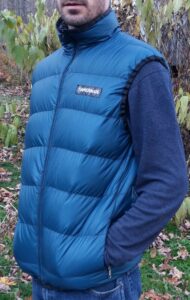Generally speaking, pockets are really important for carrying items for quick access and for keeping certain items warm in winter temperatures. However, like most good things, there are appropriate applications for them and inappropriate applications for them. For many mass-market items, weight and performance are minor goals and fashion and convenience take priority. For the gear builder who is looking at weight and performance as the primary design goals, pockets show as huge detriments to performance in many cases. The practice of including pockets on lightweight puffy garments is one example of this. When weight is placed in pockets of a puffy layer, it crushes most of the loft at the shoulder areas and pulls the loft flat across all sections above the pocket attachment point. This area usually includes the whole front side of the garment. This reduces insulation values by huge margins. The Timmermade down sweater lines go to great length to maximize the insulation potential at a light weight. Adding pockets would completely negate most of that effort. These down garments have a delicate loft that even the weight of a phone or wallet can affect. The wearer placing the full weight of hands into side pockets is enough to totally flatten huge sections.

While synthetic puffy garments like Climashield have loft with more structure that resists compression, they are also heavily affected by pocket weight. The pressure points at the shoulders are similarly crushed and shell tension causes compression across large sections, albeit to a lesser degree. Of course that loft structure is what causes synthetics to have poor compressed size and the overall insulation capacity is lower to begin with.

Shell garments like wind and rain shells have good structure for holding weight, but there are a couple major problems here too. First, these are often intended to go over insulation layers, at least in certain scenarios. This creates the same scenario as if the pockets were in the insulation layer. The weight pulls down on the fabric and crushes loft. Shell garments are typically built from non-stretchy fabrics that need to be sized a little loose for room to move. The loose structure of these shells isn’t a great place for weight since it can swing and bounce around. In the case of keeping things warm in winter, an outer shell doesn’t work. Those items need to be held close to the body, under the insulation layers.
So where is a good application for pockets. Personally, I think there are a couple good paces for them. First, I think that tight fitting inner layers with adequate structure are a good place for them. The weight is held close to the body, under insulation where it is warm. These layers are generally not lofty insulation layers so tension on the fabric isn’t detrimental. They are base layers that live under all the other layers so they remain unaffected. Second, I am a big fan of modular, stand alone pockets. Fanny packs are very popular right now and I think they provide a really great solution. All of the weight placed in them is taken by its own structure and all your clothing layers are free to do what they are good at. Since it is modular, it can be worn under insulation, or over it, depending on what you are going for.
There is one practice that is a bit left out by these other solutions. Hand warming. Pockets are great for that. Unfortunately, this is the most detrimental to a garments ability to keep the rest of you warm. You get to warm your hands, but at the direct expense of taking huge amounts of insulation away from your torso. There are some good solutions here. Using longer sleeves on your insulation garment so that your hands can be pulled up into the warmth inside the sleeves is a good one. This does a pretty good job, but isn’t quite the same as being able to slide your hands under the insulation, against your torso. For this I think the best solution is a modular hand warmer pocket. Like a fanny pack, that weight from your arms and hands would be taken by its own strap, leaving the garment to its task.